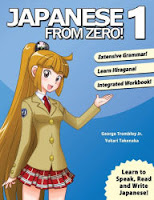Long version:
Textbooks don't excite me, but I need the basics: how to pronounce things, all about doubled vowels and syllables and how to introduce myself. I started losing interest in my third textbook, but #1 was absolutely necessary. So...
I used Japanese From Zero!, based on Amazon reviews. Here's what I liked:
- "Progressive" spelling of vocabulary words. At first, it's all roumaji (Roman letters -- our alphabet). Then, as you learn to kana (Japanese alphabet), it uses the ones you've learned so far. Eventually, it starts putting in kanji (Chinese ideographs), as you learn them.
- Thematic vocabulary lists (fast food, at the doctor's office...)
- Cute illustrations
- Covering one or two more grammatical things per chapter. And yes, by the end of the appropriate chapters, I knew when to say hoshii desu ("I want it"), suki desu ("I like it"), etc.
What I didn't like:
- The dialogues and translations are boring as hell. This may not be their fault: it's hard to be riveting when your reader's vocabulary is like tiny. Mangajin manages, though. More on that later.
- The authors almost immediately slam you with not just counting, but counting ages. Japanese counting is highly irregular, so it's work. In Chapter 11, they slam you with counting cylindrical objects, abstract objects, round things...I lose count. Too much at once.
An aside: Japanese's counters are arbitrary, often somewhat irregular, and what in computer science people call "evil and rude": that is, there's no excuse for the arbitrary difficulty. Thinking about the counters for dates in Chapter 10, I imagined this dialog:
Textbook: This is how you count in Japanese: ichi, ni, san...
Me: Got it.
Textbook: And this is how you count flat objects like papers: ichimai, nimai, sanmai...
Me: OK.
Textbook: This is how you count small round things like fruit: ikko, niko, sanko...
Me: OK, so there are some irregular forms.
Textbook: And this is how you say days of the month: tsuitachi, futsuka, mikka...
Me: Now you're just messing with me.
 Despite its difficulties, I'd take JfZ! over Japanese for Dummies, based on this problem alone: some dialogs are parts use roumaji (our alphabet) only, and others give you either roumaji or correct Japanese script, including kanji (Chinese ideographs). Since you won't know the kanji yet, you'll just skip over that, and you're not learning or getting practice with kana.
Despite its difficulties, I'd take JfZ! over Japanese for Dummies, based on this problem alone: some dialogs are parts use roumaji (our alphabet) only, and others give you either roumaji or correct Japanese script, including kanji (Chinese ideographs). Since you won't know the kanji yet, you'll just skip over that, and you're not learning or getting practice with kana.
 Around 1990 I tried learning Japanese from Japanese for Busy People. The fact that I quit may not be the book's fault: the Internet didn't exist, and it's hard to stay motivated when all you have you can read is a textbook. Looking over it today, it seems comparable to JfZ!. If you decide to get it, for God's sake get the kana version not the roumaji -- not learning to read the language is pretty limiting!
Around 1990 I tried learning Japanese from Japanese for Busy People. The fact that I quit may not be the book's fault: the Internet didn't exist, and it's hard to stay motivated when all you have you can read is a textbook. Looking over it today, it seems comparable to JfZ!. If you decide to get it, for God's sake get the kana version not the roumaji -- not learning to read the language is pretty limiting!
 Most people I meet online seem to use Genki. If I had it to do over I'd use Genki. People seem to have collected various resources to use with Genki. (Japanese from Zero's web site YesJapan exists, but doesn't have much on it that I want. Videos talking about Japanese rather than in it. The other two texts listed have publishers' sites, but no community I can find and not much in the way of extras, at least, not as compared to Genki.)
Most people I meet online seem to use Genki. If I had it to do over I'd use Genki. People seem to have collected various resources to use with Genki. (Japanese from Zero's web site YesJapan exists, but doesn't have much on it that I want. Videos talking about Japanese rather than in it. The other two texts listed have publishers' sites, but no community I can find and not much in the way of extras, at least, not as compared to Genki.)

No comments:
Post a Comment